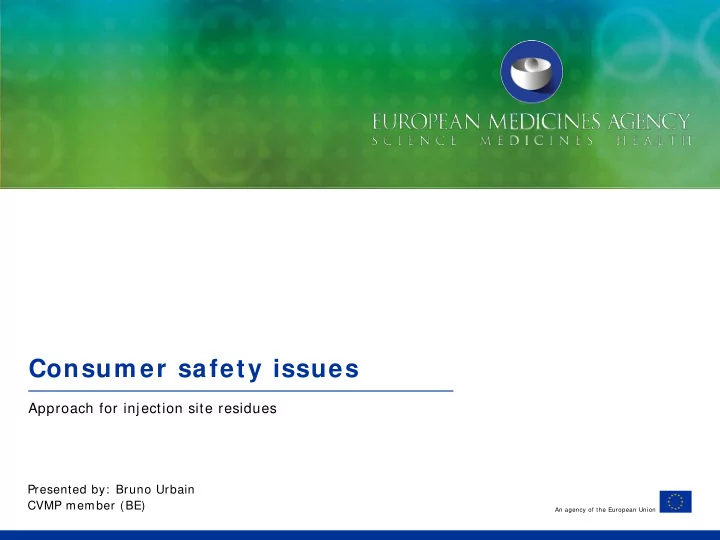

Consum er safety issues Approach for injection site residues Presented by: Bruno Urbain CVMP member (BE) An agency of the European Union
Revised reflection paper ( RP) on injection site ( I S) residues: considerations for risk assessm ent and residue surveillance Public consultation until 30/ 04/ 2014 1 st RP published in June 2008 Problem statement: • residues at IS tend to be dramatically higher than residues in non-IS muscle • muscle with different residues levels in a single carcass • difficult to set appropriate muscle MRL • Withdrawal period (WP) based on IS particularly long • MRL should ensure consumer safety and WP no longer than necessary 1 Approach for injection site residues
Conventional approach for setting MRLs • Set MRLs in non-IS muscle, fat, liver and kidney so that Theoretical Maximum Daily Intake (TMDI) < ADI • WP derived so that residues < MRL • Issues: – High residue levels at IS and slow depletion result in long WP – Not justified based on consumer safety – May reduce availability of VMP 2 Approach for injection site residues
Option to lessen the W P • set no MRL for muscle • Calculate the WP according to the ADI approach Problems at residue control: – Muscle is tissue of choice for monitoring – No legal value without MRL for muscle – Sample and analyse another tissue – No control possible to meat imported as lean cuts 3 Approach for injection site residues
Set m uscle MRL based on I S residue levels ? PROs: higher muscle MRL →→ lower WP CONs: little relevance for residue control authorities • IS are scarce and non identifiable by eye • IS residues in non - IS muscle would comply with MRL - IS even if WP not respected • Tissue distribution not respected – residues in other tissues < LOQ when IS - residues = MRL – Monitoring in non - IS muscle not informative on MRL compliance in other tissues No practical value for substances administered by other routes 4 Approach for injection site residues
Set 2 MRLs for m uscle ? Preferred approach for CVMP: MRL for non-IS muscle MRL for IS-muscle • Need 2 separate samples for monitoring • Sample1 < MRL IS < MRL non-IS →→ compliant • Sample1 < MRL IS > MRL non-IS → test sample2 < MRL non-IS → compliant > MRL non-IS → compliant • CONs – Cost – If sample2 not available ? Sample1 > MRL non-IS →→ compliant 5 Approach for injection site residues
COMPROMI SE • Establish a single MRL for muscle derived in the conventional way • Determine an alternative value for IS muscle allowing to set WP ISRRV: injection site residue reference value maximal level of residues that would be expected at the IS at the anticipated WP – TMDI calculated based on MRLs for liver, kidney and fat(+ skin) – ADI-TMDI = value allocated to 300g injection site muscle – WP: • residues at IS < ISRRV • residues in L, K, S/ F, non-IS muscle < respective MRLs 6 Approach for injection site residues
Hypothetical example - MRLs Hypothetical MRLs ( µ g/ kg): Muscle: 150 Fat: 200 30% of ADI Liver: 1000 20% of ADI 95% of ADI Kidney: 1000 ISRRV: 5000 Injection Site Residue Reference Value (ISRRV) is derived based on proportion of ADI not used by fat, liver and kidney (ie up to 80% of ADI) 7 Approach for injection site residues
CONSEQUENCES OF THE COMPROMI SE • ISRRV not published in CR 37/ 2010 • Published in the EPMAR • Not used for monitoring purposes • PROs: WP no longer than necessary no consumer safety concern • CONs – Residues at IS > MRL at WP →→ risk of non compliance – Portion of the ADI available ? (ex. room for milk) – Compliance muscle MRL = compliance ISRRV not always possible • Muscle MRL not useful for controlling overall WP when residues very low in non-IS muscle 8 Approach for injection site residues
RECOMMENDATI ONS Introduce additional measures to further minimize the possibility of sampling IS: – Injection consistently administered into one part of the animal that will not be used for residue sampling – Include in the PL the area of the animal into which injections should be administered • Non-edible tissue • Neck for cattle, swine, sheep, goats and horses • Cattle: front of shoulder blade • Horses: breast • Piglets: Sc injection in the skin fold between the hind leg and the abdomen) – Control authorities: sampling in other parts (diaphragm) – EPMAR: recommendation on which tissue to sample 9 Approach for injection site residues
ACKNOW LEDGEMENTS Prior to preparing the reflection paper CVMP consulted: • Practicing veterinarians: information on injection practices - where are food animals injected, proportion of animals that go for slaughter within 3 months of being injected, division of large dose volumes? • Residue control authorities: information on current residue control practices – tissue types used, how many tissue samples taken, which muscles used… • Meat processing industry: information on potential fate of injection sites – amount of meat from different sites used for processed products Thank you to all responders and in particular to FVE for coordination distribution and compilation of responses from practicing veterinarians. 10 Approach for injection site residues
Recommend
More recommend